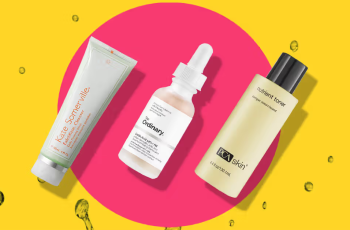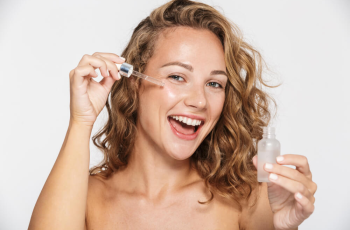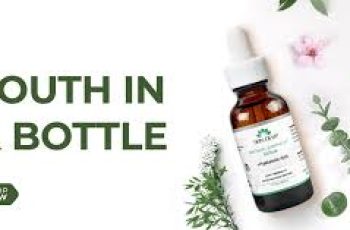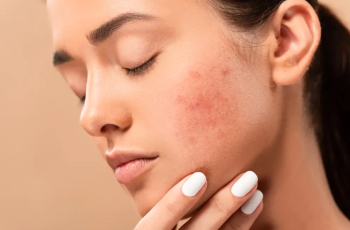.webp)
.webp)
.webp)
.webp)
Can You Use Niacinamide on Broken Skin?
.webp)
.webp)
In the ever-growing world of skincare, niacinamide has quietly earned its place as a top-tier ingredient. It might not have the flashiest name, but its benefits are hard to ignore.
.webp)
.webp)
.webp)
This humble yet powerful form of vitamin B3 is known for its hydrating, soothing, and barrier-strengthening properties. It suits nearly all skin types—dry, oily, sensitive, or combination.
.webp)
.webp)
But one important question keeps popping up:
.webp)
.webp)
.webp)
Can you use niacinamide on broken skin? Let’s explore this in detail and break down exactly how niacinamide works—especially on irritated, wounded, or peeling skin.
.webp)
.webp)
What Exactly Is Niacinamide?
.webp)
.webp)
.webp)
Niacinamide, also called nicotinamide, is a water-soluble form of vitamin B3. It’s commonly found in serums, moisturizers, and creams because of its gentle nature and versatility.
.webp)
.webp)
It offers multiple skin benefits, including:
.webp)
.webp)
.webp)
Moisture retention: It pulls water into the skin and keeps it there.
.webp)
.webp)
Sebum regulation: It controls oil levels, which is helpful for acne-prone skin.
.webp)
.webp)
.webp)
Anti-aging effects: It helps reduce fine lines and improves elasticity.
.webp)
.webp)
Brightening: It fades dark spots and improves overall tone.
.webp)
.webp)
.webp)
Barrier repair: It strengthens the outer layer of your skin, keeping irritants out.
.webp)
.webp)
Because of these properties, niacinamide is widely used in products that aim to reduce inflammation, improve skin tone, and calm irritated or damaged skin.
.webp)
.webp)
.webp)
Can You Use Niacinamide on Broken or Damaged Skin?
.webp)
.webp)
Yes, you can use niacinamide on broken skin, including areas that are irritated, flaky, or showing signs of sensitivity. In fact, niacinamide may accelerate the healing process.
.webp)
.webp)
.webp)
Its anti-inflammatory properties help soothe redness and swelling, while its hydrating abilities keep the skin moist—essential for proper healing.
.webp)
.webp)
When skin is broken—whether from acne, an allergic reaction, or over-exfoliation—it needs support to restore its protective barrier. Niacinamide helps do just that.
.webp)
.webp)
.webp)
It also promotes fibroblast activity, which aids in rebuilding tissue and speeding up wound repair. And unlike harsher actives, niacinamide rarely causes stinging or irritation.
.webp)
.webp)
Can You Put Niacinamide on an Open Wound or Flare-Up?
.webp)
.webp)
.webp)
Yes, niacinamide can be applied to minor open wounds, acne flare-ups, and rosacea patches. It helps by encouraging skin regeneration and soothing inflammation.
.webp)
.webp)
Topical niacinamide may even help prevent post-inflammatory hyperpigmentation—a common concern after acne or skin injuries heal.
.webp)
.webp)
.webp)
That said, everyone’s skin reacts differently. If your wound is deep, infected, or bleeding, skip skincare products and consult a medical professional first.
.webp)
.webp)
But for surface-level damage or mild irritation, niacinamide can be a safe and helpful option to promote healing and comfort.
.webp)
.webp)
.webp)
Can You Use Niacinamide on Peeling Skin?
.webp)
.webp)
Absolutely. Niacinamide is one of the best ingredients you can use on peeling or flaky skin.
.webp)
.webp)
.webp)
Whether it’s from sunburn, overuse of exfoliants, or a retinol reaction, niacinamide helps hydrate and calm the skin while encouraging natural cell turnover.
.webp)
.webp)
It reinforces the skin’s natural barrier, reducing moisture loss and preventing further irritation. This helps the skin return to a healthy, balanced state more quickly.
.webp)
.webp)
.webp)
Niacinamide also minimizes tightness and discomfort often experienced with peeling, and helps prep the skin for better absorption of other hydrating ingredients.
.webp)
.webp)
Can You Apply Niacinamide on Open Pimples?
.webp)
.webp)
.webp)
Yes, you can. In fact, niacinamide is often a go-to ingredient for treating active or healing pimples, including open ones.
.webp)
.webp)
It reduces inflammation, helps the skin heal faster, and lowers the risk of acne scars forming after a breakout.
.webp)
.webp)
.webp)
Once a pimple bursts or becomes an open lesion, the surrounding skin becomes vulnerable to bacteria, dehydration, and pigment changes.
.webp)
.webp)
Niacinamide works to calm inflammation, protect the area, and support tissue regeneration—all while being much gentler than traditional acne treatments like benzoyl peroxide.
.webp)
.webp)
.webp)
Does Niacinamide Ever Make Skin Worse?
.webp)
.webp)
For most people, niacinamide is very well-tolerated. It doesn’t cause purging like exfoliating acids or retinoids. However, a few people may experience breakouts or irritation.
.webp)
.webp)
.webp)
If you experience issues, it may be due to:
A high concentration of niacinamide (above 10%)
Using it with conflicting actives like strong acids
An underlying skin condition that needs professional care
In rare cases, people may react to other ingredients in the formula, not the niacinamide itself. If irritation continues beyond 2–4 weeks, consult a dermatologist.
Start with a lower concentration (2–5%) if you’re new to niacinamide and gradually build up your skin’s tolerance.
What Helps Broken Skin Heal Faster?
If you’re dealing with broken or damaged skin, the best thing you can do is keep the area moist and protected. Healing skin thrives in a hydrated environment.
Here are key tips:
Use humectants like niacinamide or hyaluronic acid to draw in moisture.
Apply occlusive ingredients like petroleum jelly to lock it in.
Avoid products with alcohol, strong acids, or fragrances.
Stick to a simple routine until the skin recovers.
Hydration speeds healing, prevents cracking, and keeps skin comfortable. Apply your products gently—no rubbing or scrubbing.
What Should You Put on Broken Skin Pimples?
If a pimple has popped, been picked, or burst open, your next steps matter. Applying the wrong thing can lead to scarring, redness, or prolonged healing.
Here’s what to avoid applying to broken pimples:
Benzoyl peroxide
Salicylic acid
Sulphur treatments
Alcohol-based toners or spot treatments
Instead, apply niacinamide, aloe vera, or zinc-based creams. These reduce redness, encourage healing, and soothe inflammation.
Finish with a light moisturizer to prevent dryness. During the day, sunscreen is essential to prevent post-inflammatory hyperpigmentation.
Can You Use Niacinamide Every Day?
Yes, you can safely use niacinamide once or twice daily, depending on your skin’s tolerance and your overall routine.
It plays nicely with most skincare ingredients, including:
Hyaluronic acid
Ceramides
Peptides
Retinol (if introduced slowly)
SPF products
Use it after cleansing and before heavier moisturizers or oils. If layering with other serums, apply the thinner, water-based products first.
How to Add Niacinamide to a Damaged Skin Routine
Here’s a simple routine you can follow if your skin is broken, dry, or irritated:
Morning Routine:
Gentle cleanser
Niacinamide serum (2–5%)
Lightweight moisturizer
SPF 30 or higher
Evening Routine:
Cleanse gently with lukewarm water
Reapply niacinamide serum
Follow with a hydrating night cream or barrier balm
Avoid using exfoliants, peels, or retinoids until your skin fully heals. Focus on barrier-repairing ingredients like niacinamide, ceramides, and squalane.
Final Thoughts: Is Niacinamide Safe for Broken Skin?
Yes, niacinamide is a safe, gentle, and effective ingredient for use on broken skin. It supports the healing process, reduces inflammation, and protects against further damage.
From open pimples to peeling patches, niacinamide offers hydration, comfort, and defense—without the harsh side effects of stronger actives.
Just remember:
Start slow if you’re new to the ingredient.
Use clean hands and apply gently.
Avoid high concentrations if your skin is extra sensitive.
As always, if you’re unsure about a specific skin condition or product, consult with a dermatologist or healthcare provider.
Have more skincare questions? Reach out to us anytime over on Instagram @Procoal. One of our skincare experts will be happy to chat with you in the DMs!

.webp)
.webp)
.webp)
.webp) Can You Use Niacinamide on Broken Skin?
Can You Use Niacinamide on Broken Skin?
.webp)
.webp) In the ever-growing world of skincare, niacinamide has quietly earned its place as a top-tier ingredient. It might not have the flashiest name, but its benefits are hard to ignore.
In the ever-growing world of skincare, niacinamide has quietly earned its place as a top-tier ingredient. It might not have the flashiest name, but its benefits are hard to ignore.
.webp)
.webp)
.webp) This humble yet powerful form of vitamin B3 is known for its hydrating, soothing, and barrier-strengthening properties. It suits nearly all skin types—dry, oily, sensitive, or combination.
This humble yet powerful form of vitamin B3 is known for its hydrating, soothing, and barrier-strengthening properties. It suits nearly all skin types—dry, oily, sensitive, or combination.
.webp)
.webp) But one important question keeps popping up:
But one important question keeps popping up:
.webp)
.webp)
.webp) Can you use niacinamide on broken skin? Let’s explore this in detail and break down exactly how niacinamide works—especially on irritated, wounded, or peeling skin.
Can you use niacinamide on broken skin? Let’s explore this in detail and break down exactly how niacinamide works—especially on irritated, wounded, or peeling skin.
.webp)
.webp) What Exactly Is Niacinamide?
What Exactly Is Niacinamide?
.webp)
.webp)
.webp) Niacinamide, also called nicotinamide, is a water-soluble form of vitamin B3. It’s commonly found in serums, moisturizers, and creams because of its gentle nature and versatility.
Niacinamide, also called nicotinamide, is a water-soluble form of vitamin B3. It’s commonly found in serums, moisturizers, and creams because of its gentle nature and versatility.
.webp)
.webp) It offers multiple skin benefits, including:
It offers multiple skin benefits, including:
.webp)
.webp)
.webp) Moisture retention: It pulls water into the skin and keeps it there.
Moisture retention: It pulls water into the skin and keeps it there.
.webp)
.webp) Sebum regulation: It controls oil levels, which is helpful for acne-prone skin.
Sebum regulation: It controls oil levels, which is helpful for acne-prone skin.
.webp)
.webp)
.webp) Anti-aging effects: It helps reduce fine lines and improves elasticity.
Anti-aging effects: It helps reduce fine lines and improves elasticity.
.webp)
.webp) Brightening: It fades dark spots and improves overall tone.
Brightening: It fades dark spots and improves overall tone.
.webp)
.webp)
.webp) Barrier repair: It strengthens the outer layer of your skin, keeping irritants out.
Barrier repair: It strengthens the outer layer of your skin, keeping irritants out.
.webp)
.webp) Because of these properties, niacinamide is widely used in products that aim to reduce inflammation, improve skin tone, and calm irritated or damaged skin.
Because of these properties, niacinamide is widely used in products that aim to reduce inflammation, improve skin tone, and calm irritated or damaged skin.
.webp)
.webp)
.webp) Can You Use Niacinamide on Broken or Damaged Skin?
Can You Use Niacinamide on Broken or Damaged Skin?
.webp)
.webp) Yes, you can use niacinamide on broken skin, including areas that are irritated, flaky, or showing signs of sensitivity. In fact, niacinamide may accelerate the healing process.
Yes, you can use niacinamide on broken skin, including areas that are irritated, flaky, or showing signs of sensitivity. In fact, niacinamide may accelerate the healing process.
.webp)
.webp)
.webp) Its anti-inflammatory properties help soothe redness and swelling, while its hydrating abilities keep the skin moist—essential for proper healing.
Its anti-inflammatory properties help soothe redness and swelling, while its hydrating abilities keep the skin moist—essential for proper healing.
.webp)
.webp) When skin is broken—whether from acne, an allergic reaction, or over-exfoliation—it needs support to restore its protective barrier. Niacinamide helps do just that.
When skin is broken—whether from acne, an allergic reaction, or over-exfoliation—it needs support to restore its protective barrier. Niacinamide helps do just that.
.webp)
.webp)
.webp) It also promotes fibroblast activity, which aids in rebuilding tissue and speeding up wound repair. And unlike harsher actives, niacinamide rarely causes stinging or irritation.
It also promotes fibroblast activity, which aids in rebuilding tissue and speeding up wound repair. And unlike harsher actives, niacinamide rarely causes stinging or irritation.
.webp)
.webp) Can You Put Niacinamide on an Open Wound or Flare-Up?
Can You Put Niacinamide on an Open Wound or Flare-Up?
.webp)
.webp)
.webp) Yes, niacinamide can be applied to minor open wounds, acne flare-ups, and rosacea patches. It helps by encouraging skin regeneration and soothing inflammation.
Yes, niacinamide can be applied to minor open wounds, acne flare-ups, and rosacea patches. It helps by encouraging skin regeneration and soothing inflammation.
.webp)
.webp) Topical niacinamide may even help prevent post-inflammatory hyperpigmentation—a common concern after acne or skin injuries heal.
Topical niacinamide may even help prevent post-inflammatory hyperpigmentation—a common concern after acne or skin injuries heal.
.webp)
.webp)
.webp) That said, everyone’s skin reacts differently. If your wound is deep, infected, or bleeding, skip skincare products and consult a medical professional first.
That said, everyone’s skin reacts differently. If your wound is deep, infected, or bleeding, skip skincare products and consult a medical professional first.
.webp)
.webp) But for surface-level damage or mild irritation, niacinamide can be a safe and helpful option to promote healing and comfort.
But for surface-level damage or mild irritation, niacinamide can be a safe and helpful option to promote healing and comfort.
.webp)
.webp)
.webp) Can You Use Niacinamide on Peeling Skin?
Can You Use Niacinamide on Peeling Skin?
.webp)
.webp) Absolutely. Niacinamide is one of the best ingredients you can use on peeling or flaky skin.
Absolutely. Niacinamide is one of the best ingredients you can use on peeling or flaky skin.
.webp)
.webp)
.webp) Whether it’s from sunburn, overuse of exfoliants, or a retinol reaction, niacinamide helps hydrate and calm the skin while encouraging natural cell turnover.
Whether it’s from sunburn, overuse of exfoliants, or a retinol reaction, niacinamide helps hydrate and calm the skin while encouraging natural cell turnover.
.webp)
.webp) It reinforces the skin’s natural barrier, reducing moisture loss and preventing further irritation. This helps the skin return to a healthy, balanced state more quickly.
It reinforces the skin’s natural barrier, reducing moisture loss and preventing further irritation. This helps the skin return to a healthy, balanced state more quickly.
.webp)
.webp)
.webp) Niacinamide also minimizes tightness and discomfort often experienced with peeling, and helps prep the skin for better absorption of other hydrating ingredients.
Niacinamide also minimizes tightness and discomfort often experienced with peeling, and helps prep the skin for better absorption of other hydrating ingredients.
.webp)
.webp) Can You Apply Niacinamide on Open Pimples?
Can You Apply Niacinamide on Open Pimples?
.webp)
.webp)
.webp) Yes, you can. In fact, niacinamide is often a go-to ingredient for treating active or healing pimples, including open ones.
Yes, you can. In fact, niacinamide is often a go-to ingredient for treating active or healing pimples, including open ones.
.webp)
.webp) It reduces inflammation, helps the skin heal faster, and lowers the risk of acne scars forming after a breakout.
It reduces inflammation, helps the skin heal faster, and lowers the risk of acne scars forming after a breakout.
.webp)
.webp)
.webp) Once a pimple bursts or becomes an open lesion, the surrounding skin becomes vulnerable to bacteria, dehydration, and pigment changes.
Once a pimple bursts or becomes an open lesion, the surrounding skin becomes vulnerable to bacteria, dehydration, and pigment changes.
.webp)
.webp) Niacinamide works to calm inflammation, protect the area, and support tissue regeneration—all while being much gentler than traditional acne treatments like benzoyl peroxide.
Niacinamide works to calm inflammation, protect the area, and support tissue regeneration—all while being much gentler than traditional acne treatments like benzoyl peroxide.
.webp)
.webp)
.webp) Does Niacinamide Ever Make Skin Worse?
Does Niacinamide Ever Make Skin Worse?
.webp)
.webp) For most people, niacinamide is very well-tolerated. It doesn’t cause purging like exfoliating acids or retinoids. However, a few people may experience breakouts or irritation.
For most people, niacinamide is very well-tolerated. It doesn’t cause purging like exfoliating acids or retinoids. However, a few people may experience breakouts or irritation.
.webp)
.webp)
.webp) If you experience issues, it may be due to:
A high concentration of niacinamide (above 10%)
Using it with conflicting actives like strong acids
An underlying skin condition that needs professional care
In rare cases, people may react to other ingredients in the formula, not the niacinamide itself. If irritation continues beyond 2–4 weeks, consult a dermatologist.
Start with a lower concentration (2–5%) if you’re new to niacinamide and gradually build up your skin’s tolerance.
What Helps Broken Skin Heal Faster?
If you’re dealing with broken or damaged skin, the best thing you can do is keep the area moist and protected. Healing skin thrives in a hydrated environment.
Here are key tips:
Use humectants like niacinamide or hyaluronic acid to draw in moisture.
Apply occlusive ingredients like petroleum jelly to lock it in.
Avoid products with alcohol, strong acids, or fragrances.
Stick to a simple routine until the skin recovers.
Hydration speeds healing, prevents cracking, and keeps skin comfortable. Apply your products gently—no rubbing or scrubbing.
What Should You Put on Broken Skin Pimples?
If a pimple has popped, been picked, or burst open, your next steps matter. Applying the wrong thing can lead to scarring, redness, or prolonged healing.
Here’s what to avoid applying to broken pimples:
Benzoyl peroxide
Salicylic acid
Sulphur treatments
Alcohol-based toners or spot treatments
Instead, apply niacinamide, aloe vera, or zinc-based creams. These reduce redness, encourage healing, and soothe inflammation.
Finish with a light moisturizer to prevent dryness. During the day, sunscreen is essential to prevent post-inflammatory hyperpigmentation.
Can You Use Niacinamide Every Day?
Yes, you can safely use niacinamide once or twice daily, depending on your skin’s tolerance and your overall routine.
It plays nicely with most skincare ingredients, including:
Hyaluronic acid
Ceramides
Peptides
Retinol (if introduced slowly)
SPF products
Use it after cleansing and before heavier moisturizers or oils. If layering with other serums, apply the thinner, water-based products first.
How to Add Niacinamide to a Damaged Skin Routine
Here’s a simple routine you can follow if your skin is broken, dry, or irritated:
Morning Routine:
Gentle cleanser
Niacinamide serum (2–5%)
Lightweight moisturizer
SPF 30 or higher
Evening Routine:
Cleanse gently with lukewarm water
Reapply niacinamide serum
Follow with a hydrating night cream or barrier balm
Avoid using exfoliants, peels, or retinoids until your skin fully heals. Focus on barrier-repairing ingredients like niacinamide, ceramides, and squalane.
Final Thoughts: Is Niacinamide Safe for Broken Skin?
Yes, niacinamide is a safe, gentle, and effective ingredient for use on broken skin. It supports the healing process, reduces inflammation, and protects against further damage.
From open pimples to peeling patches, niacinamide offers hydration, comfort, and defense—without the harsh side effects of stronger actives.
Just remember:
Start slow if you’re new to the ingredient.
Use clean hands and apply gently.
Avoid high concentrations if your skin is extra sensitive.
As always, if you’re unsure about a specific skin condition or product, consult with a dermatologist or healthcare provider.
Have more skincare questions? Reach out to us anytime over on Instagram @Procoal. One of our skincare experts will be happy to chat with you in the DMs!
If you experience issues, it may be due to:
A high concentration of niacinamide (above 10%)
Using it with conflicting actives like strong acids
An underlying skin condition that needs professional care
In rare cases, people may react to other ingredients in the formula, not the niacinamide itself. If irritation continues beyond 2–4 weeks, consult a dermatologist.
Start with a lower concentration (2–5%) if you’re new to niacinamide and gradually build up your skin’s tolerance.
What Helps Broken Skin Heal Faster?
If you’re dealing with broken or damaged skin, the best thing you can do is keep the area moist and protected. Healing skin thrives in a hydrated environment.
Here are key tips:
Use humectants like niacinamide or hyaluronic acid to draw in moisture.
Apply occlusive ingredients like petroleum jelly to lock it in.
Avoid products with alcohol, strong acids, or fragrances.
Stick to a simple routine until the skin recovers.
Hydration speeds healing, prevents cracking, and keeps skin comfortable. Apply your products gently—no rubbing or scrubbing.
What Should You Put on Broken Skin Pimples?
If a pimple has popped, been picked, or burst open, your next steps matter. Applying the wrong thing can lead to scarring, redness, or prolonged healing.
Here’s what to avoid applying to broken pimples:
Benzoyl peroxide
Salicylic acid
Sulphur treatments
Alcohol-based toners or spot treatments
Instead, apply niacinamide, aloe vera, or zinc-based creams. These reduce redness, encourage healing, and soothe inflammation.
Finish with a light moisturizer to prevent dryness. During the day, sunscreen is essential to prevent post-inflammatory hyperpigmentation.
Can You Use Niacinamide Every Day?
Yes, you can safely use niacinamide once or twice daily, depending on your skin’s tolerance and your overall routine.
It plays nicely with most skincare ingredients, including:
Hyaluronic acid
Ceramides
Peptides
Retinol (if introduced slowly)
SPF products
Use it after cleansing and before heavier moisturizers or oils. If layering with other serums, apply the thinner, water-based products first.
How to Add Niacinamide to a Damaged Skin Routine
Here’s a simple routine you can follow if your skin is broken, dry, or irritated:
Morning Routine:
Gentle cleanser
Niacinamide serum (2–5%)
Lightweight moisturizer
SPF 30 or higher
Evening Routine:
Cleanse gently with lukewarm water
Reapply niacinamide serum
Follow with a hydrating night cream or barrier balm
Avoid using exfoliants, peels, or retinoids until your skin fully heals. Focus on barrier-repairing ingredients like niacinamide, ceramides, and squalane.
Final Thoughts: Is Niacinamide Safe for Broken Skin?
Yes, niacinamide is a safe, gentle, and effective ingredient for use on broken skin. It supports the healing process, reduces inflammation, and protects against further damage.
From open pimples to peeling patches, niacinamide offers hydration, comfort, and defense—without the harsh side effects of stronger actives.
Just remember:
Start slow if you’re new to the ingredient.
Use clean hands and apply gently.
Avoid high concentrations if your skin is extra sensitive.
As always, if you’re unsure about a specific skin condition or product, consult with a dermatologist or healthcare provider.
Have more skincare questions? Reach out to us anytime over on Instagram @Procoal. One of our skincare experts will be happy to chat with you in the DMs!



